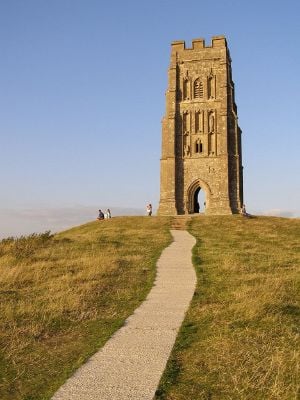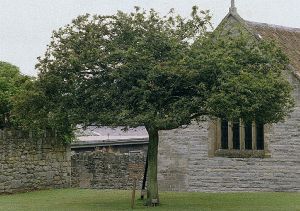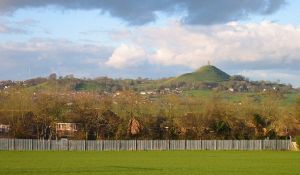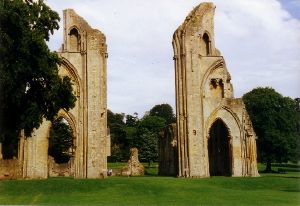Glastonbury
Glastonbury is a small British town famed for its ancient monastic sites and alleged connections to religious figures. The town, which lies among the ditches and low meadows of the Somerset plain in England, boasts a population of 8,800 inhabitants. The small patch of land has been a pilgrimage site for hundreds of years, and many of the pilgrims are attracted to the ancient ruins.
The main point of access for Glastonbury is through either Bristol or Bath, major neighboring metroples. While easily accessible by car or train, Glastonbury remains distant enoughfrom the big cities to maintain the quaint qualities of a small British market town. As a small market town; however, Glastonbury must come into contact with the ways of the big city once a year. During the annual Glastonbury Festival, tourists and locals alike stream into the nearby town of Pilton and severely impact the small town.
History
The origins of Glastonbury are deeply rooted in myth and religious affiliation. According to the prevailing mythology, the Somerset plain was once a swampy, wet terrain unsuitable for human occupation. The only area in the region that was suitable for settlement, according to this myth, was the high land of Glastonbury. As the most attractive location, the elevated plot of land hosted Romans, Saxons, and an early abbey. According to myth of Glastonbury, Joseph of Arimathea made his way to the famed monastary of Glastonury, as well as St. Patrick. The Celtic monatary grew from its early origins to become one of the most wealthy religious centers of all of Europe.
The growth of the monastary was fueled by the multitude of myths surrounding the nearby hill, Glastonbury Tor. Many pilgrims who sought guidance at the monastary of Glastonbury also sought time on the hill, which was thought by many to hold the holy grail. According to myth, Joseph of Arimathea hid the holy grail in a small church built on the hill. Believers in this version of Glastonbury history hold that the small church built by Joseph was the first Christian Church in England. Under this idea, Glastonbury Tor is seen as the birthplace of British Christianity.
As the center of the town, the abbey came to dominate life in Glastonbury. Industry in particular was supported by the expanding monastary, as the church began to support thr development of tanners and other craftsmen in the area to provide much needed supplies for the abbey. The abbey continued to expand until 1184, when a savage fire destroyed much of the development. For those seeking a conection to medieval Glastonbury; however, a small portion of the monastic remains are still visible for the inquisitive tourist or pilgrim.
One particularly prominent myth in the Glastonbury story regards the Glastonbury Thorn ( or Holy Thorn). According to legend, Josepth of Arimathea arrived at the monastary at a time when the wet Somerset Levels were only passable by boat. Arriving on the shores of Glastonbury, the legend states that he placed his staff on the shore to steady his step. From where his staff hit the ground of Glastonbury, a small thorny bush sprung up. Many feel that the presence of the Crataegus hawthorn tree in Glastonbury confirms this particular myth, as it is not found to grow anywhere else in the world.
While many of the myths about glastonbury history focus on the alleged role of Joseph of Arimathea in contributing to the town, a mythological counterpart exists that supports that idea that it was King Arthur, not Joseph of Arimathea, that contributed the most to the town. According to this mythological camp, glastonbury is the modern manifestation of the mythical city of Avalon, where Arthur and Guinevere were laid to rest. Accounts also claim that Lancelot sought the refuge of Glastonbury Abbey after the death of King Arthur.
Fueled by the legacy of myth, Glastonbury continues to attract hordes of tourists annually who strive to reconnect with ancient times. Most of the tourists seekt he ruins of the Abbey, which are still open to visitors. Only small portions of the original structures remain; however, both due to the fire that ravaged the town in the early 12th century and the tendency for local builders to use abandoned stones when building modern structures. Visitors who wish to envision the abbey that once was a bustling commercial center must content themselves with the Abbot's Kitchen and Lady's Chapel, two strongly preserved edifices. [1])Tourists can also learn more about the history of the town at the nearby Somerset Rural LIfe Museum.
Economy
The economy of Glastonbury maintains many of the characteristics of a traditional market town: local produce is still prominent and market exchange takes place in small scale relationships. Key agricultural products in the lower elevations, that are neccesarily more damp, include peat and withes for basket making. Herds of cattle are still a common site roaming the hills of Glastonbury, and the milk drawn from the herds is used to make Cheddar Cheese, the region's distict type of cheese.
In the higher elevations of Glastonbury, where the air is drier, strawberries and apple orchards dot the landscape. Another common site in the less damp regions is field after field of grape vines. Vineyards have always been a typical agricultural crop of the region, with some historians claiming that the crop can be traced to Roman times.
The nearby village of Street has blossomed from its humble beginnings as a market town into an industrial center. Street is particularly noted for its export of leather shoes by the Clarks family, so many of the Glastonbury inhabitants have access to great bargains on leather goods. Despite becoming an export center;however, Street maintains its small town feeling, reassuring many that the encroachments of the future will not be able to change the character of life in Glastonbury.
Culture and People
Glastonbury is an eclectic mix of inhabitants: those who have lived their whole life in Glastonbury, those who have moved to Glastobury to escape the world, and those who are drawn by the spiritual legacy of the city. Priding itslelf on its vibrant and dynamic character, Glastonbury plays host to many independent thinkers who are simply trying to escape the outside world. Many of the artistic sorts who frequent Glastonbury flock to the city during the annual Glastonbury Festival.
The hippie generation of the 1960s and 1970s also contributed heavily to establishing Glastonbury as a center for alternative religious study. The summer solstice of 1971 was a particularly poignant moment in the alternative history of Glastonbury, as nearby hills flooded with people attempting the experience the season change at the mythological site. This mass gathering of spiritual individuals is often compared with Woodstock in the United States for the sheer number of attendees and alternative ideas.
Since the late 1990s, glastonbury has also hosted an annual Glastonbury Symposium for Crop Circles and Signs of our Time, where attendees attenpt to unravel the sybolize behind crop circles and similiar physical structures. Conferences like the Symposium for Crop Circles are commonly hosted in Glastonbury, and the crop circle enthusiasts are joined by the Goddess Convention, the Avalon Pipers, and an assortment of pyscadelic rock bands in called Glastonbury a friendly meeting place.
ReferencesISBN links support NWE through referral fees
- ↑ Abbot's Kitchen, Glastonbury Abbey. Images of England. Retrieved 2006-11-11.
- Geoffrey Ashe, King Arthur's Avalon: The Story of Glastonbury, 1957
- Costantino, Maria. 2001. The Illustrated Flag Handbook. New York: Gramercy Books. ISBN 0-517-21810-0
- Lewis, Brenda Ralph. 2002. Great Civilizations. Bath: Paragon Publishing. ISBN 0-75256-141-3
See also
- Glastonbury Tor
- Glastonbury Abbey
- A Glastonbury Romance by John Cowper Powys
- King Arthur
External links
- Official town council and community websiteRetrieved December 15, 2007.
- The Glastonbury search engineRetrieved December 15, 2007.
- Isle of AvalonRetrieved December 15, 2007.
- Library of Avalon (specialist esoterica)
- Glastonbury Pilgrimage Association, Annual Christian pilgrimage led by local churches Retrieved December 15, 2007.
- Glastonbury Pilgrim Reception Centre Support and advice for pilgrims researching their visit to Glastonbury Retrieved December 15, 2007.
- Glastonbury, The Somerset Urban Archaeological Survey by Clare Gathercole Retrieved December 15, 2007.
- Benedictine Abbey of Glastonbury A History of the County of Somerset: Vol 2: (1911) Retrieved December 15, 2007.
- Photos of Glastonbury in 3d (Anaglyphs) Retrieved December 15, 2007.
Credits
New World Encyclopedia writers and editors rewrote and completed the Wikipedia article in accordance with New World Encyclopedia standards. This article abides by terms of the Creative Commons CC-by-sa 3.0 License (CC-by-sa), which may be used and disseminated with proper attribution. Credit is due under the terms of this license that can reference both the New World Encyclopedia contributors and the selfless volunteer contributors of the Wikimedia Foundation. To cite this article click here for a list of acceptable citing formats.The history of earlier contributions by wikipedians is accessible to researchers here:
The history of this article since it was imported to New World Encyclopedia:
Note: Some restrictions may apply to use of individual images which are separately licensed.



